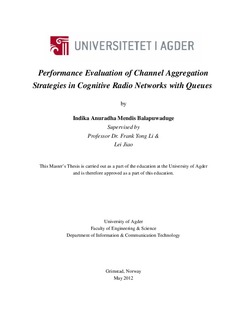| dc.description.abstract | With the growing usage of wireless communication devices, demand for the spectrum access is rapidly increasing.
Therefore, an efficient spectrum management and spectrum access techniques are necessary and critical.
However, studies on spectrum usage have revealed that most of the allotted spectrum is not used efficiently due
to the static frequency allocation methods. With the evolution of cognitive radio, spectrum access techniques
shift from static spectrum allocation to dynamic allocation with enhanced features such as spectrum sensing and
spectrum adaptation.
In the first part of this thesis, we study several spectrum access techniques in cognitive radio networks, which
have been developed with spectrum adaptation. The performance of cognitive radio systems are evaluated in
terms of capacity, blocking probability and forced termination probability of the secondary network. Due to the
strict priority over primary users, the performance of the secondary network is restricted. One of the successful
solutions to further improve the system performance by increasing the capacity and decreasing the blocking
and forced termination probabilities is the integration of a queuing model. Most of already designed queuing
models for cognitive radio systems have been designed with certain limitations of performance. Therefore in
this thesis, a bunch of techniques of performance improvement have been taken into account when designing the
queuing model. The features: channel aggregation, spectrum handover, channel sharing, priority based queuing
and heterogeneous traffic are considered together in order to model the queuing system as much as more realistic
way which can further enhance the overall system performance.
In the second part of this thesis, we propose a queuing system referred to as Priority based Multiple Queue
System (PMQS) which is designed with two queues separately for the real time and non-real time secondary
user services. Channel access opportunities are distributed between two queues such a way that the real time
services have the higher priority than elastic services. Two queuing approaches are introduced based on the
queuing ability of the interrupted non-real time services. Continuous time Markov chain models are developed
to evaluate the system performance in terms of capacity, blocking and forced termination probabilities of the
secondary network. In addition, we explore the cost analysis of the proposed queuing model in terms of mean
queuing delay. Other than that, spectrum utilization of the cognitive radio system is also evaluated. In order to
minimize the associated queuing delay, a maximum value for the number of waiting lines inside a queue is set
instead of an infinite queue size . Analytical results reveal that integration of the proposed queuing model could
increase the capacity of the secondary network while decreasing the blocking probability. And also one of the
proposed queuing methods can further decrease the forced termination rate of non-real time traffic. Associated
queuing delay is controlled by proper selection of maximum queue sizes. For these reasons, it can be concluded
that the proposed queuing model can be used to improve the system performance of multi-channel cognitive
radio networks. | no_NO |
